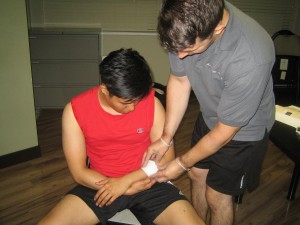Introduction
When heat comes into contact with the skin, it can often causes scalds and burns. Dry heat that you would receive from an iron or a fire is the type of heat that is going to cause burns. Burns often cause the skin to become red and blistered, or in extreme burns this can cause charred, blackened skin. While a scald is caused by wet heat, the type of heat that is found from steam of very hot water. Both are painful and damaging to the skin.
Burns and Scalds: Treatment

In order to treat a burn or scald on the skin, there are several aspects to remember:
- To stop the burning, remove the person from the heat source immediately to avoid further damage to the skin.
- Utilize cool or lukewarm water to cool the burn. You will want to use this water for around 10 to 30 minutes depending upon the severity of the burn. Never use ice, iced water, greasy substances or creams on the burn.
- Painkillers like ibuprofen or paracetamol can be utilized to help with pain.
- Remove clothing or jewelry that is close to the area of burnt skin, however, if there are items stuck to the burn area on the skin, do not touch this.
- Do cover the burn with a thin layer of cling film.
- Keep the person warm, but avoid letting a blanket hit the burned skin.
How to Prevent Burns and Scalds
There are several things you can do in order to prevent burns and scalds that happen. In many situations babies and young children are often the victims, so you should aim to avoid these types of serious accidents at home:
- Always keep flames out of the reach of children, including candles, lighters, matches and the like.
- Hot drinks should never be given to children.
- Test water temperature of bath water and other waters with your elbow to see how hot this is going to be for the child.
- Do not let the kids play in the kitchen especially when you are cooking and heat is present.
Medical Attention: When to Get It
The treatment of burns and scalds can be at home, if it is not too serious. Those serious burns are going to require that you get medical attention. If the burn has any of these properties, you need to get to your nearest hospital:
- Electrical burns
- Chemical burns
- Burns that cover a large area of your skin, larger than your hand
- Thick burns that may be causing white or charred skin
- Burns that are on areas of the body that often cause blisters, burns located on the face, feet, legs, genitals, feet and arms.
Medical attention should also be given to those who have been inhaling smoke or fumes. Those who do breathe in smoke or fumes could begin to cough, have problems breathing regularly, a sore throat and even have burns on their face.
Pregnant women and children who are under the age of five are at a greater risk for the side effects of burns, and as such should seek medical attention. When severe cases are present, skin graft surgeries may be the best option for care.
Related Video On Burns and Scalds
https://www.youtube.com/watch?v=2pVGG09VmfQ
